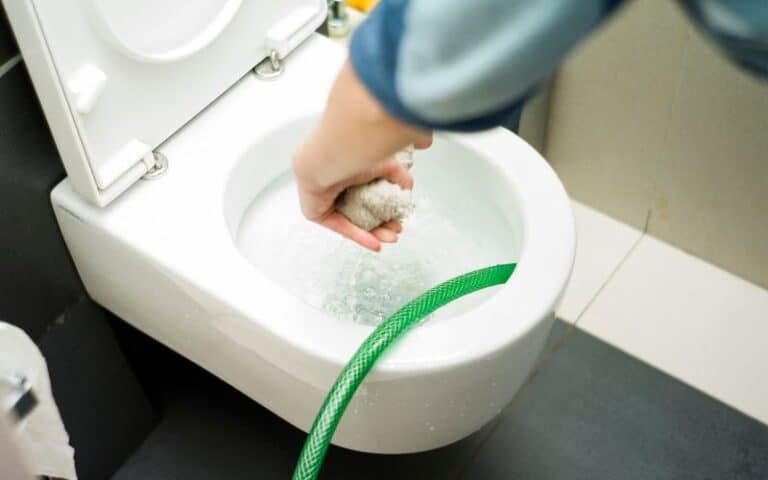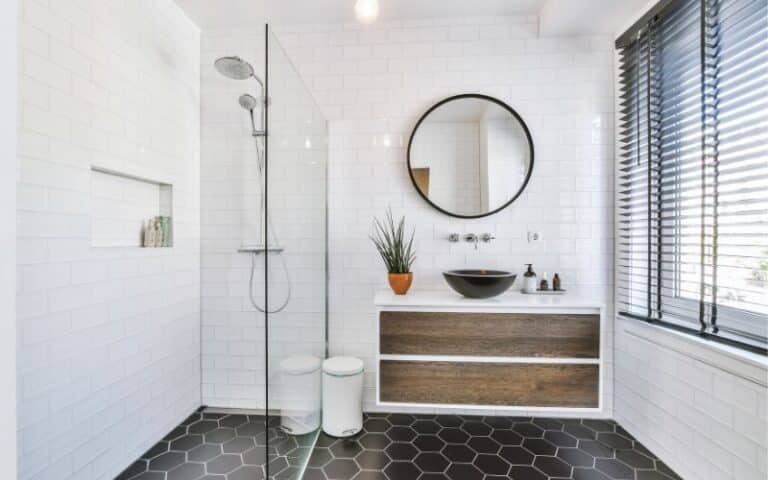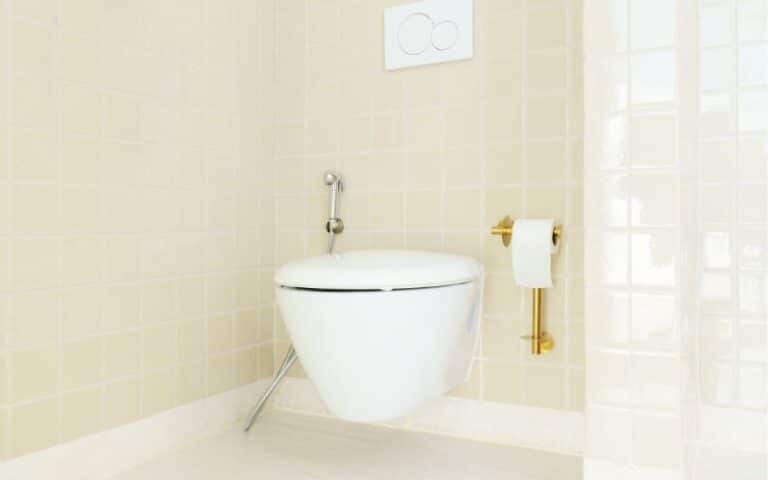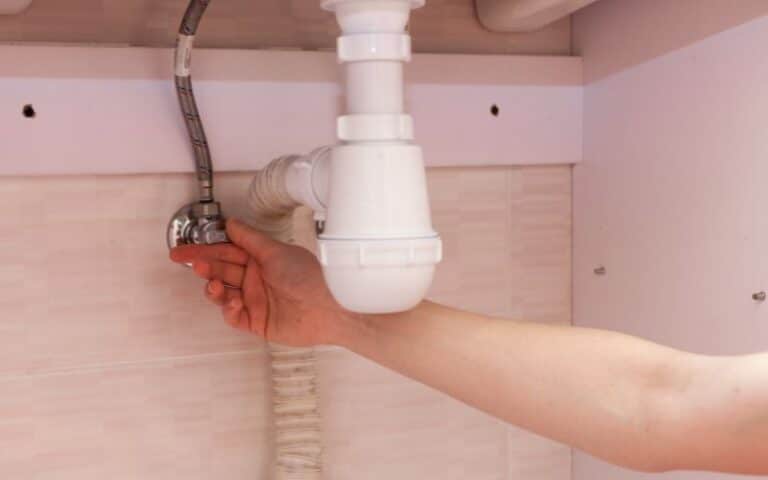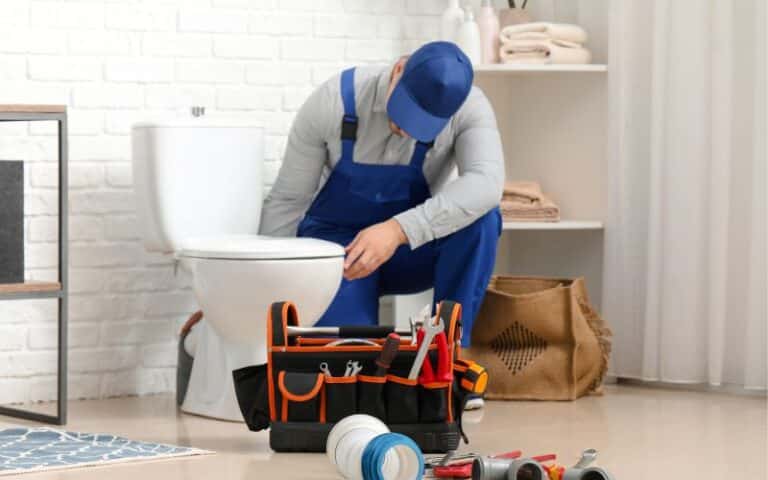A common issue with toilet bolts is their spinning issues. This issue can be quite embarrassing.
A toilet anchor’s sole purpose is to firmly keep the toilet seat in place. So, it’s worrying when its anchor bolts become too loose and starts to spin.
This guide assists you in examining common reasons why this spinning may occur and some possible fixes.
Over-tightening or corrosion can strip the threads on the bolt or flange, causing the bolt to spin. Often, a loose or unsecured flange leads the anchor bolts on your toilet to spin. Also, a cracked toilet flange can cause these bolts to spin. Over time, bolts can become worn, rusted, or bent, which can make them easier to spin.
For whatever reason, your toilet bolts may begin to spin; one thing is sure, they can create uncomfortable situations.
However, you need not fret. In this guide, we’ll explain the possible causes of spinning bolts and the easiest fixes for them.
By the end, you should be able to identify and fix any future issues that may occur with your toilet bolts, anchors, or just your toilet in general.
4 Reasons Why Toilet Bolts Keep Spinning With Solutions
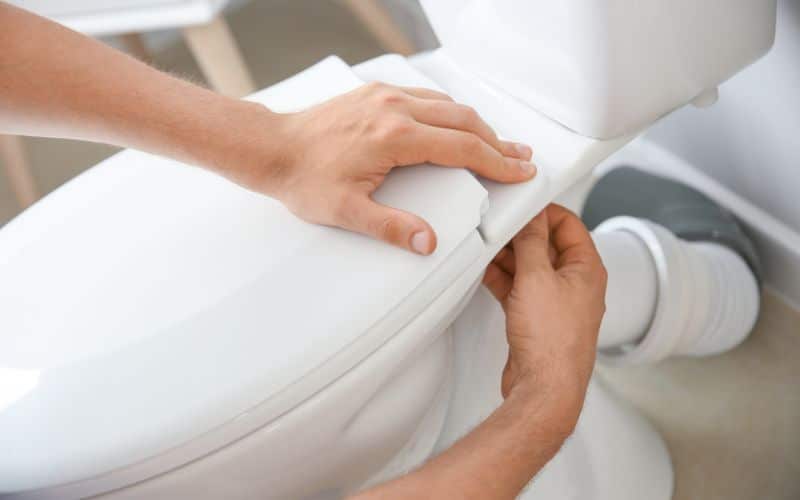
Toilet anchor bolts may seem small, but they play a fairly significant role in making sure your toilet stays firmly in place.
So, identifying the issue with these bolts is the first step to solving any issue you’re experiencing with them.
Thus, here are four possible reasons your toilet bolts keep spinning and some easy steps you can take to resolve them.
#1. Stripped Threads on Flange
When the threads on the bolts get stripped, the bolts can no longer grip the nut tightly, and the nut becomes loose, leading to a wobbly and unstable toilet seat.
These bolts can get stripped either because of old age or due to over-tightening. Over-tightening the bolts can cause the threads to wear down and become stripped over time.
If the threads on the flange are stripped, the bolt won’t be able to screw in enough to hold the toilet down securely, and the bolt may spin without tightening or loosening.
In this case, you may need to use a repair kit that includes new bolts and a new flange to fix the problem.
Replace or repair the bolts and flanges as soon as possible to prevent further damage and improve the stability of the toilet seat.
Solutions
One solution to the problem of stripped threads on toilet bolts to prevent spinning is to wrap the threads on the handle bolt with Teflon tape. However, this solution is temporal.
Another solution is to replace the stripped bolt with a new one, installing it correctly and tightening it appropriately.
If the toilet bowl flange is damaged, it may also need to be replaced. It’s important to address this issue promptly to prevent any toilet or floor damage.
Here are five ways to solve the problem of stripped threads on toilet bolts to prevent spinning:
- Fill the stripped thread with toothpicks or wooden dowels coated in wood glue. Once the glue dries, you can reinsert the bolt, and it should grip the new wood material, preventing spinning.
- Remove the bolt and insert a larger diameter bolt into the stripped hole. You may need to drill out the hole slightly to accommodate the larger bolt.
- Use a repair kit designed specifically for stripped toilet bolt holes. These kits typically include an insert that fits into the hole and provides new threads for the bolt to grip.
- If the toilet base is made of porcelain or other fragile material, consider using a brass insert in the hole to provide new threads.
- Replace the toilet base entirely if the damage is too severe to repair. This may be necessary if the toilet has been improperly installed or if the damage is extensive.
#2. Loose Flange
A loose toilet flange can cause toilet bolts to spin because the flange is the anchor point for the bolts that secure the toilet to the floor.
If the flange is loose, it means that it’s not securely attached to the subfloor, which can allow the flange to shift when weight is applied to the toilet.
This shifting can cause the toilet bolts to become loose, which can lead to the toilet becoming unstable and wobbling.
Furthermore, when the bolts become loose, they can spin freely in their holes within the flange. This spinning can make removing the nuts that secure the bolts to the toilet base very difficult.
In some cases, the bolts can become stripped or damaged as they spin within the flange, which in turn makes them even more difficult to remove.
Additionally, if the bolts are spinning within the flange, they may not be providing adequate support for the toilet.
This can cause the toilet to become even more unstable and may increase the risk of leaks or damage to the toilet or the surrounding flooring.
Therefore, it’s important to ensure that the toilet flange is securely attached to the subfloor and that the bolts are tightened properly.
Nevertheless, if you’re experiencing a loose flange or spinning bolts, you may need to consult a plumber or other professional for assistance in repairing or replacing the flange and bolts.
Solutions
Below is a step-by-step guide on solving the problem of a loose flange on toilet bolts to prevent spinning:
- Tighten the bolts: Use a wrench to tighten the bolts further and ensure that they are snug to prevent the toilet from wobbling.
- Add shims: Insert plastic shims or metal washers between the base of the toilet and the flange to provide extra stability. It’ll help keep the toilet from moving and prevent spinning bolts.
- Replace the wax ring: Replace the wax ring that seals the toilet to the flange. That would ensure a tight seal and prevent movement that can loosen the bolts.
- Use a flange extender: Install a flange extender over the existing flange to raise it above the floor level and provide a more secure base for the toilet.
- Upgrade to a higher quality flange: Replace the existing flange with a higher quality one made from materials like brass or stainless steel to provide greater stability and durability.
#3. Cracked Flange
A cracked or broken flange underneath a toilet can cause the bolts that hold the toilet in place to spin.
The flange, which is typically made of PVC plastic or cast iron and sits on top of a drainpipe, provides a stable base for the toilet to be secured to the floor.
So, if the flange is cracked or broken, it can’t provide a reliable base for the toilet, and the bolts securing the toilet to the flange will experience lateral motion and spinning.
When the toilet is tightened using the bolts, the pressure applied by the tightening is distributed evenly across the base of the toilet.
However, if the flange is cracked or broken, it can’t provide the necessary level of support.
Without proper support, the bolts will not be able to remain in place, and the toilet may begin to move or rock.
If the bolt spins as you turn the nut, it indicates that it is no longer being held in place by the flange.
Similarly, a spinning toilet bolt can cause leakages in the wax seal between the toilet bowl and the flange.
Because over time, the seal could wear out, causing water to leak out of the base of the toilet, which could lead to more extensive water damage in the bathroom.
It’s essential to have a cracked or broken flange repaired or replaced as soon as you discover it to avoid the risk of costly water damage.
Solutions
These are some simple ways you can fix and/or prevent the cracking of toilet anchor bolts to further avoid the spinning of the bolts.
- Remove the Toilet and Replace the Flange: The most permanent solution involves removing the toilet and replacing the flange with a new one.
- Install a Repair Flange: A repair flange can be installed over the damaged flange. This provides a secure surface for the toilet mounting bolts.
- Use a Toilet Flange Extender: A flange extender can be inserted into the existing flange to raise its height and provide a solid surface for the bolts to secure the toilet.
- Use a Flange Support: A flange support, sometimes referred to as a brace, can be installed under the damaged flange to provide additional support.
- Use Epoxy to Repair the Cracked Flange: You can use Epoxy to fill in the cracks and provide a stable surface for the toilet mounting bolts.
- Use Wedges to Secure the Toilet: Sometimes, the toilet flange is too damaged to repair. In such cases, use plastic toilet wedges to secure the toilet to the floor and prevent spinning.
Always remember to follow proper safety precautions when attempting any plumbing repairs.
If you’re unsure or not comfortable performing these repairs, it’s best to consult a professional plumber.
#4. Worn-Out or Rusted Bolts
To understand how worn-out or rusted bolts can cause toilet bolts to spin, it’s important to first understand the components of a toilet.
A toilet base is usually secured to the bathroom floor with bolts, which pass through the toilet flange and are tightened by nuts underneath the flange.
The toilet bowl is then secured to the base using a set of bolts and nuts. However, due to exposure to moisture and regular use, these bolts can become corroded and rusted.
When this happens, the bolts may become weak and brittle, making them more prone to breaking or bending.
If the bolts become too corroded, they may not be able to hold the toilet securely and the toilet may wobble or rock.
Also, if the bolts become loose due to wear and tear or rust, they may spin rather than tighten or loosen when you turn them with a wrench.
These can be problematic when trying to remove or tighten the bolts during regular maintenance or replacement of the toilet.
A spinning bolt can be frustrating, as it may not move in either direction. Which makes it difficult to remove or tighten the nut or to remove the bolt completely.
When this happens, you may need to use specialized tools such as an oscillating tool, an angle grinder, or a mini-hacksaw.
You’d need these tools to carefully cut through the rusted bolt or remove the nut from the flange.
Always note that using bolt cutters may not be the best option, as they may not be able to cut through the steel bolts safely and could lead to further damage to the toilet or flange.
In summary, corroded or rusted bolts can cause toilet bolts to spin, making removing or tightening them difficult.
Thus, to address this issue, specialized tools may be required to carefully remove the bolt or nut to prevent further damage or complications.
So, it’s important to regularly inspect your toilet bolts and nuts and replace them if you notice any signs of corrosion or wear and tear.
Solutions
If you’re experiencing spinning toilet bolts due to worn-out or rusted bolts, there are a few steps you can take to fix the issue:
- Turn off the water supply: Before you start any repairs, turn off the water supply to the toilet to prevent any leaks.
- Remove the toilet: To access the toilet bolts, you may need to remove the toilet.
Start by draining any water out of the toilet bowl and tank, then loosen the nuts holding the toilet to the floor. Lift the toilet bowl off the flange and set it aside. - Remove the old bolts: Once you have access to the bolts, remove the old bolts and nuts. If the bolts are rusted, you may need to use penetrating oil and wait a few hours to loosen them up.
- Replace the bolts: Install new bolts and nuts in place of the old ones. Make sure the bolts are the correct length and fit snugly into the flange.
- Reinstall the toilet: Carefully lower the toilet bowl back onto the flange, ensuring the bolts go through the holes in the toilet’s base.
Tighten the nuts on the bolts, but be careful not to overtighten them, as this can crack the toilet bowl. - Test for leaks: Finally, turn the water supply back on and check for any leaks around the base of the toilet. If everything looks good, you’re done!
If you encounter any difficulties during the process, it may be best to consult a professional plumber to ensure the job is completed correctly.
How to Prevent Toilet Anchor Bolts From Spinning?
Undoubtedly, fixing a spinning toilet anchor bolt takes a lot of effort and time. Not to mention the discomfort you first have to experience using the toilet that way.
Therefore, it’d be best to prevent your toilet from spinning. Since we’ve outlined the cause of toilet bolts’ spinning, we can now better prevent its occurrence.
Below are some of the best steps to stop or prevent toilet bolts from spinning and leading to further problems.
- Start by turning off the water supply to the toilet.
- Remove the toilet by disconnecting the water supply line and removing the caps covering the anchor bolts.
- Loosen the nuts securing the anchor bolts to the flange and lift them off the flange.
- Clean the flange and the area around the anchor bolt holes with a wire brush or scraper to remove any debris, dirt, or rust.
- Apply a generous amount of silicone caulk to the base of each anchor bolt and the flange around the bolt holes.
- Insert each anchor bolt into its hole and screw the nut onto the bolt, tightening it snugly by hand.
- Use a wrench to tighten each anchor bolt nut an additional half turn. Be careful not to over-tighten, or you may crack the toilet.
- Reinstall the toilet, ensuring it is level and firmly seated. Reconnect the water supply and turn it back on.
Note: You may also consider using no-spin toilet flange bolts or a toilet anchor kit to prevent the anchor bolts from spinning in the future.
What Is the Recommended Anchor Bolts Size for Toilets?
The recommended size of anchor bolts for toilets varies depending on the toilet model and the size of the flange.
However, anchor bolts for toilets are generally between 1/4 inch and 5/16 inch in diameter.
However, it’s crucial to check the toilet manufacturer’s specifications to determine the appropriate bolt size for your toilet model.
It’s also essential to choose the appropriate length of the anchor bolts. Because when the bolts are too short, they won’t secure the toilet adequately.
But, if they’re too long, they can damage the flange or interfere with the toilet’s installation.
Typically, toilet anchor bolts come in lengths ranging from 2-1/4 to 3-1/2 inches, but it’s important to refer to the manufacturer’s specifications for your specific toilet model.
Can You Replace Toilet Bolts Without Removing the Toilet?
Yes, it’s possible to replace toilet bolts without removing the toilet. One method involves cutting the bolts using a hacksaw or reciprocating saw.
While also removing the old bolts and nuts and installing new bolts and nuts.
Another method involves using a product like The Toilet Master, which is designed for easy installation of new toilet bolts without the need for tools or cutting.
However, these methods may not work in all cases, and it may be necessary to remove the toilet for more extensive repairs or replacements.
So, to replace toilet bolts without removing the toilet, you can follow these steps:
- Turn off the water supply to the toilet by closing the shut-off valve behind the toilet.
- Flush the toilet to drain the water from the tank and bowl.
- Use a wrench to loosen the nuts that secure the bolts to the toilet base.
- Lift the toilet slightly to remove the old bolts and nuts.
- Replace the old bolts and nuts with new ones. You can also use bolts with a break-off feature or adjustable bolts designed to fit any toilet.
- Tighten the nuts by hand to secure the new bolts in place. Be careful not to overtighten and crack the porcelain base of the toilet.
A snug fit with a slight turn of the wrench is sufficient. - Reconnect the water supply and turn the water back on.
- Test the toilet for leaks and make sure it’s securely in place on the floor.
Nevertheless, you should also consider the disadvantages of replacing these toilet bolts as much as the advantages.
Thus, here are some common pros and cons of replacing your toilet anchor bolts without completely removing your toilet.
| Pros | Cons |
|---|---|
| Saves time and effort | Not always a permanent solution |
| Requires the use of fewer tools | Might require additional repairs |
| Can be done without professional help | Not suitable for toilets with corroded bolts |
| Can extend the life of old toilets. | Often leads to leakage or toilet instability |
| Creates less mess during the process. | Requires the purchase of specialized tools. |
How Long Do Toilet Anchor Bolts Last After Installation?
The lifespan of toilet anchor bolts can vary depending on several factors, including the quality of the bolts, the installation process, and the environment in which the toilet is installed.
So, it’s generally recommended to use high-quality stainless steel bolts during toilet installation, as they are less susceptible to rust and corrosion.
If you install them properly, stainless steel bolts can last for many years, potentially even the toilet’s lifetime.
However, improper installation or exposure to a harsh environment can lead to premature degradation of the bolts.
For example, if the bolts are over-tightened during installation, it can cause them to bend or break, which can significantly reduce their lifespan.
Additionally, exposure to moisture or corrosive chemicals can cause the bolts to rust or degrade over time, especially if they are not properly sealed or protected.
Generally, inspecting the toilet anchor bolts periodically is important to ensure they are still in good condition and functioning properly.
If the bolts are showing signs of rust or corrosion, or if they are loose or unstable, it may be necessary to replace them to ensure the longevity and stability of the toilet.
Overall, with proper installation and maintenance, toilet anchor bolts can last for many years and provide reliable performance over the life of the toilet.


